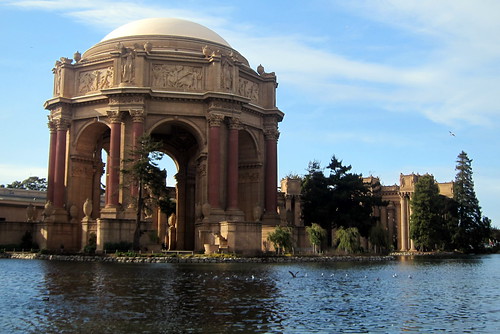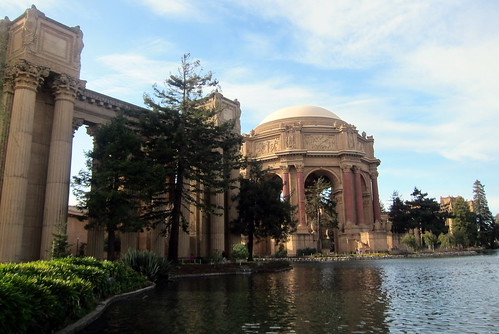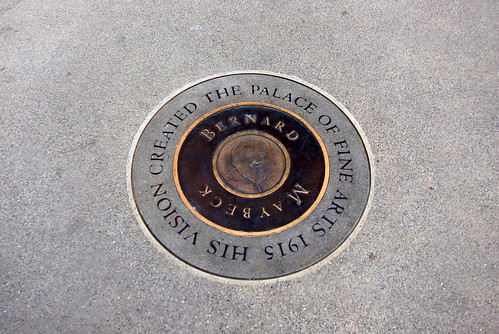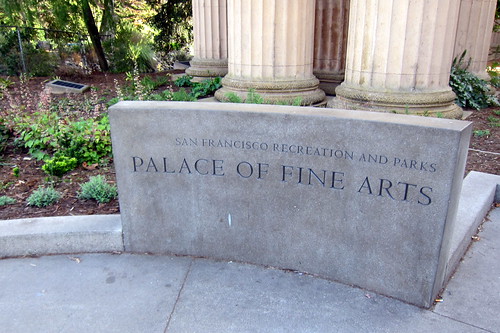San Francisco - Marina District: Palace of Fine Arts
Image by wallyg
The Palace of Fine Arts was designed by Bernard Maybeck and constructed for 1915 Panama-Pacific Exposition. It is one of the few surviving structures from the Exposition, and the only one still situated on its original site. Built' around a small artificial lagoon, The Palace of Fine Arts is composed of a wide, 1100 foot pergola, an arch formed by rows of Corinthian columns framing a wide walkway, around a central rotunda situated by the water. Ornamentation includes Bruno Louis Zimm's three repeating panels around the entablature of the rotunda representing "The Struggle for the Beautiful" symbolizing Greek culture, while Ulric Ellerhusen supplied the weeping women atop the colonnade and the sculptured frieze and allegorical figures representing Contemplation, Wonderment and Meditation. The underside of the Palace rotunda's dome features eight large insets, which originally contained murals by Robert Reid.
The Palace, one of ten palaces at the heart of the Exhibition--the others being the palaces of Education, Liberal Arts, Manufactures, Varied Industries, Agriculture, Food Products, Transportation, Mines and Metallurgy, and Machinery--was designed to to look like a Roman or Greek ruin. While most of the exposition was demolished, it survived due to the efforts of the Paaace Preservation League. For a time, the Palace housed art exhibits, and during the Great Depression, W.P.A. artists were commissioned to replace the decayed Robert Reid murals on the ceiling of the rotunda. From 1934 to 1942, it was home to eighteen lighted tennis courts. During World War II it was requisitioned by the military for storage of trucks and jeeps. Starting in 1947, the hall was used as a city Park Department warehouse, a telephone book distribution center, a flag and tent storage depot, and a temporary Fire Department headquarters.
By the 1950s, the Palace's structure had in fact fallen into ruins and in 1964 it was demolished, with only the steel structure left standing. The buildings were reconstructed in permanent, light-weight, poured-in-place concrete, and steel I-beams were hoisted into place for the dome of the rotunda. The decorations and sculpture were reconstructed and the only changes were the absence of the murals in the dome, two end pylons of the colonnade, and the original ornamentation of the exhibit hall. In 1969 the former Exhibit Hall became home to the Exploratorium interactive museum, and in 1970 also became the home of the 1,000 seat Palace of Fine Arts Theater.
National Register #04000659 (2005)
San Francisco - Marina District: Palace of Fine Arts
Image by wallyg
The Palace of Fine Arts was designed by Bernard Maybeck and constructed for 1915 Panama-Pacific Exposition. It is one of the few surviving structures from the Exposition, and the only one still situated on its original site. Built' around a small artificial lagoon, The Palace of Fine Arts is composed of a wide, 1100 foot pergola, an arch formed by rows of Corinthian columns framing a wide walkway, around a central rotunda situated by the water. Ornamentation includes Bruno Louis Zimm's three repeating panels around the entablature of the rotunda representing "The Struggle for the Beautiful" symbolizing Greek culture, while Ulric Ellerhusen supplied the weeping women atop the colonnade and the sculptured frieze and allegorical figures representing Contemplation, Wonderment and Meditation. The underside of the Palace rotunda's dome features eight large insets, which originally contained murals by Robert Reid.
The Palace, one of ten palaces at the heart of the Exhibition--the others being the palaces of Education, Liberal Arts, Manufactures, Varied Industries, Agriculture, Food Products, Transportation, Mines and Metallurgy, and Machinery--was designed to to look like a Roman or Greek ruin. While most of the exposition was demolished, it survived due to the efforts of the Paaace Preservation League. For a time, the Palace housed art exhibits, and during the Great Depression, W.P.A. artists were commissioned to replace the decayed Robert Reid murals on the ceiling of the rotunda. From 1934 to 1942, it was home to eighteen lighted tennis courts. During World War II it was requisitioned by the military for storage of trucks and jeeps. Starting in 1947, the hall was used as a city Park Department warehouse, a telephone book distribution center, a flag and tent storage depot, and a temporary Fire Department headquarters.
By the 1950s, the Palace's structure had in fact fallen into ruins and in 1964 it was demolished, with only the steel structure left standing. The buildings were reconstructed in permanent, light-weight, poured-in-place concrete, and steel I-beams were hoisted into place for the dome of the rotunda. The decorations and sculpture were reconstructed and the only changes were the absence of the murals in the dome, two end pylons of the colonnade, and the original ornamentation of the exhibit hall. In 1969 the former Exhibit Hall became home to the Exploratorium interactive museum, and in 1970 also became the home of the 1,000 seat Palace of Fine Arts Theater.
National Register #04000659 (2005)
San Francisco - Marina District: Palace of Fine Arts
Image by wallyg
The Palace of Fine Arts was designed by Bernard Maybeck and constructed for 1915 Panama-Pacific Exposition. It is one of the few surviving structures from the Exposition, and the only one still situated on its original site. Built' around a small artificial lagoon, The Palace of Fine Arts is composed of a wide, 1100 foot pergola, an arch formed by rows of Corinthian columns framing a wide walkway, around a central rotunda situated by the water. Ornamentation includes Bruno Louis Zimm's three repeating panels around the entablature of the rotunda representing "The Struggle for the Beautiful" symbolizing Greek culture, while Ulric Ellerhusen supplied the weeping women atop the colonnade and the sculptured frieze and allegorical figures representing Contemplation, Wonderment and Meditation. The underside of the Palace rotunda's dome features eight large insets, which originally contained murals by Robert Reid.
The Palace, one of ten palaces at the heart of the Exhibition--the others being the palaces of Education, Liberal Arts, Manufactures, Varied Industries, Agriculture, Food Products, Transportation, Mines and Metallurgy, and Machinery--was designed to to look like a Roman or Greek ruin. While most of the exposition was demolished, it survived due to the efforts of the Paaace Preservation League. For a time, the Palace housed art exhibits, and during the Great Depression, W.P.A. artists were commissioned to replace the decayed Robert Reid murals on the ceiling of the rotunda. From 1934 to 1942, it was home to eighteen lighted tennis courts. During World War II it was requisitioned by the military for storage of trucks and jeeps. Starting in 1947, the hall was used as a city Park Department warehouse, a telephone book distribution center, a flag and tent storage depot, and a temporary Fire Department headquarters.
By the 1950s, the Palace's structure had in fact fallen into ruins and in 1964 it was demolished, with only the steel structure left standing. The buildings were reconstructed in permanent, light-weight, poured-in-place concrete, and steel I-beams were hoisted into place for the dome of the rotunda. The decorations and sculpture were reconstructed and the only changes were the absence of the murals in the dome, two end pylons of the colonnade, and the original ornamentation of the exhibit hall. In 1969 the former Exhibit Hall became home to the Exploratorium interactive museum, and in 1970 also became the home of the 1,000 seat Palace of Fine Arts Theater.
National Register #04000659 (2005)
San Francisco - Marina District: Palace of Fine Arts
Image by wallyg
The Palace of Fine Arts was designed by Bernard Maybeck and constructed for 1915 Panama-Pacific Exposition. It is one of the few surviving structures from the Exposition, and the only one still situated on its original site. Built' around a small artificial lagoon, The Palace of Fine Arts is composed of a wide, 1100 foot pergola, an arch formed by rows of Corinthian columns framing a wide walkway, around a central rotunda situated by the water. Ornamentation includes Bruno Louis Zimm's three repeating panels around the entablature of the rotunda representing "The Struggle for the Beautiful" symbolizing Greek culture, while Ulric Ellerhusen supplied the weeping women atop the colonnade and the sculptured frieze and allegorical figures representing Contemplation, Wonderment and Meditation. The underside of the Palace rotunda's dome features eight large insets, which originally contained murals by Robert Reid.
The Palace, one of ten palaces at the heart of the Exhibition--the others being the palaces of Education, Liberal Arts, Manufactures, Varied Industries, Agriculture, Food Products, Transportation, Mines and Metallurgy, and Machinery--was designed to to look like a Roman or Greek ruin. While most of the exposition was demolished, it survived due to the efforts of the Paaace Preservation League. For a time, the Palace housed art exhibits, and during the Great Depression, W.P.A. artists were commissioned to replace the decayed Robert Reid murals on the ceiling of the rotunda. From 1934 to 1942, it was home to eighteen lighted tennis courts. During World War II it was requisitioned by the military for storage of trucks and jeeps. Starting in 1947, the hall was used as a city Park Department warehouse, a telephone book distribution center, a flag and tent storage depot, and a temporary Fire Department headquarters.
By the 1950s, the Palace's structure had in fact fallen into ruins and in 1964 it was demolished, with only the steel structure left standing. The buildings were reconstructed in permanent, light-weight, poured-in-place concrete, and steel I-beams were hoisted into place for the dome of the rotunda. The decorations and sculpture were reconstructed and the only changes were the absence of the murals in the dome, two end pylons of the colonnade, and the original ornamentation of the exhibit hall. In 1969 the former Exhibit Hall became home to the Exploratorium interactive museum, and in 1970 also became the home of the 1,000 seat Palace of Fine Arts Theater.
National Register #04000659 (2005)
San Francisco - Marina District: Palace of Fine Arts
Image by wallyg
The Palace of Fine Arts was designed by Bernard Maybeck and constructed for 1915 Panama-Pacific Exposition. It is one of the few surviving structures from the Exposition, and the only one still situated on its original site. Built' around a small artificial lagoon, The Palace of Fine Arts is composed of a wide, 1100 foot pergola, an arch formed by rows of Corinthian columns framing a wide walkway, around a central rotunda situated by the water. Ornamentation includes Bruno Louis Zimm's three repeating panels around the entablature of the rotunda representing "The Struggle for the Beautiful" symbolizing Greek culture, while Ulric Ellerhusen supplied the weeping women atop the colonnade and the sculptured frieze and allegorical figures representing Contemplation, Wonderment and Meditation. The underside of the Palace rotunda's dome features eight large insets, which originally contained murals by Robert Reid.
The Palace, one of ten palaces at the heart of the Exhibition--the others being the palaces of Education, Liberal Arts, Manufactures, Varied Industries, Agriculture, Food Products, Transportation, Mines and Metallurgy, and Machinery--was designed to to look like a Roman or Greek ruin. While most of the exposition was demolished, it survived due to the efforts of the Paaace Preservation League. For a time, the Palace housed art exhibits, and during the Great Depression, W.P.A. artists were commissioned to replace the decayed Robert Reid murals on the ceiling of the rotunda. From 1934 to 1942, it was home to eighteen lighted tennis courts. During World War II it was requisitioned by the military for storage of trucks and jeeps. Starting in 1947, the hall was used as a city Park Department warehouse, a telephone book distribution center, a flag and tent storage depot, and a temporary Fire Department headquarters.
By the 1950s, the Palace's structure had in fact fallen into ruins and in 1964 it was demolished, with only the steel structure left standing. The buildings were reconstructed in permanent, light-weight, poured-in-place concrete, and steel I-beams were hoisted into place for the dome of the rotunda. The decorations and sculpture were reconstructed and the only changes were the absence of the murals in the dome, two end pylons of the colonnade, and the original ornamentation of the exhibit hall. In 1969 the former Exhibit Hall became home to the Exploratorium interactive museum, and in 1970 also became the home of the 1,000 seat Palace of Fine Arts Theater.
National Register #04000659 (2005)
No comments:
Post a Comment